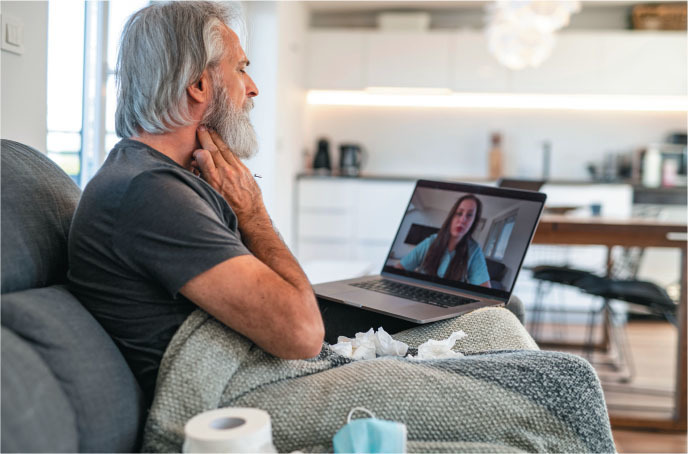
Covid-19: Deepening The Conversation: Why Not Home
BY , MHA, MSN, RN, ACM-RN, AND , DNP, MSN, BA, RN, ACM-RN
There is no doubt that COVID-19 has necessitated an environment of rapid change in the healthcare landscape, driving patient care delivery systems beyond traditional management of length of stay, bed capacity, and slower adoption of some technologies. The pandemic created an immediate need to look through a new lens to meet the complexities around care coordination for hospitalized patients ensuring safe and sustainable pathways beyond the acute care setting. Now more than ever, the expertise of case management is being leveraged and at the forefront of care delivery. Addressing length of stay challenges, enhancing collaboration, and integrating technological concepts have been and will be paramount to ensuring patients remain at the center of care.
With the influx of COVID-19 patients into hospitals, many case managers almost immediately began working remotely or away from the medical units. The utilization of technology, telemedicine, iPads and AZMANJAKAsmart phones became the key tools of communication for staff engaging with patients and families. Team huddles shifted from in person to virtual, texting and secure chat processes were enacted, and concise medical record documentation became pivotal in an effort to clearly articulate the care plan. The emphasis on length of stay (LOS) became a key focus, as COVID-19 created significant barriers to discharging patients, leading to hospital bed capacity challenges at a time when every bed was seen as a national treasure.
Waivers with the intent of immediately transitioning patients to post-acute facilities coupled with added stipends to daily reimbursement rates were not enough to move the volume of patients needed to ease the bed capacity burden. Establishing a gold standard post-acute care collaborative network with the most engaged partners became critical to understanding the impact of COVID-19 on their ability to accept patients and ensure safe and timely patient transitions. It became necessary to augment traditional post-acute venues with dedicated COVID-19 positive hoteling, shelters and congregate living settings. These initiatives required conversations and collaboration between healthcare entities at local, state and federal levels to address deeply rooted barriers to transitioning patients through the healthcare continuum.
While post-acute care facilities strived to continue accepting admissions from hospitals, admission freezes for resident safety were unavoidable, significantly impacting LOS and throughput. With the inability to discharge patients to another care setting and patients fearing going to congregate living settings, the concept of “why not home” gained traction with clinical teams, care coordinators and patients. The pandemic both created a need and highlighted the effectiveness of care delivery in non-traditional settings. The utilization of in-home telehealth monitoring and provider telehealth visits reinvigorated and accelerated the conversations around the concept of “Hospital At Home.”
According to Cheney (2020), “hospital-at-home programs provide inpatient-level care to patients in their homes such as daily supervision by doctors or nurses in-person or virtually via telemedicine. Hospital-at-home programs provide a higher level of care than traditional home health services, which generally focus on skilled nursing and physical therapy.” This Medicare program for qualifying conditions has significant potential to increase hospital bed capacity, reduce length of stay and decrease readmissions by decreasing gaps in care caused by patient movement from one care setting to another. Hospitalized patients and those triaged in the emergency department would have the opportunity to participate in hospital level home-based care. Case management will play an integral role in preparing patients for the hospital at home experience through comprehensive resource allocation based on medical and psychosocial assessments with an emphasis on social determinants of health.
Focusing collaborative efforts to provide both high quality and high acuity services in the home has the potential to enhance both health outcomes and possibly reduce the cost of care. Perhaps the greatest opportunity for patients recovering in the comfort and safety of their own home is the opportunity to promote increased patient engagement in their plan of care and path to wellness, potentially leading to enhanced patient satisfaction and elevated health outcomes.
The palpable impact of COVID-19 compelled rapid change to all entities within the care continuum resulting in innovative partnerships and programs, with technology leading the way. The challenge ahead is not to revert to less effective traditional practices, but to build upon the momentum toward strategies that provide a future of sustainable healthcare delivery. Case management continues to be mission critical in the future with a focus on closing care continuum gaps and ensuring organizational stewardship. Safeguarding patient centered care remains the hallmark of why we do what we do.
REFERENCE
Cheney, (2020). CMS launches new hospital-at-home program. Healthleaders. Retrieved April 2021 from https://www.healthleadersmedia.com/clinical-care/cms-launches-new-hospital-home-program






